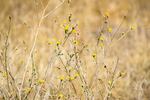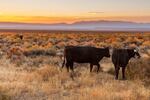“We could see the end of a lifestyle as we know it if something good doesn't happen. And I'm not sure what that's gonna' be."Chris Cunningham, Rockin' J Ranch, Oregon/Washington”
Invasive Species take a toll on the way many Oregonians live. Weeds are infesting ranches and farms and are causing an economic crisis in agriculture. Gardeners struggle to keep native landscapes free of invading exotics. Fishermen are hauling in exotic species like green crabs and mitten crabs instead of valuable Dungeness crab, salmon and oysters. The extra time, money, and resources spent coping with invaders is something many landowners and fishermen can ill afford.

Yellow Star thistle.
Jon Sullivan/Flickr
A Thorn In The Side Of Oregon
The Yellow Star thistle is a notorious ranch destroyer. And when ranches disappear so does a way of life. Yellow Star Thistle is an invader from Eurasia that was first reported in California in 1869. It now infests between 10 and 15 million acres of California and has spread to 48 states. When it showed up on the Idaho and Washington side of Hells Canyon in the 1980's, ranchers immediately felt the consequences. This spiny, prolific and mildly toxic weed replaced vast swaths of native bunchgrass. As cattle boss Chris Cunningham put it, "we don't make our living off of cows, we make our living of grass ... if we don't have the grass there's not gonna be any cows out here." Unfortunately, yellow star has already caused some ranchers to call it quits on a generations-old way of life. The good news? Land managers in Northeast Oregon are now counterattacking with an arsenal of new herbicides and biocontrols to keep yellow star from spreading into some of the last, best range in Hells Canyon.
How Are Biocontrols Tested?
Cowboys and ranchers are hoping an army of bugs can help save their way of life. They're called biocontrols but they're really just three varieties of "seed eating weevils": Bangasternus orientalis, Eustenopus villosus and Larinus curtus. These bugs have voracious appetites and devour the seed heads of yellow star thistle. The results so far are good. But biocontrols are also a non-native species. So how can we know whether biocontrols won't also become invasive? The short answer is that no one can guarantee with 100 percent certainty that biocontrols won't get "out of control", but rigorous testing is required before any biocontrols are released.

Cattle grazing at sunset on open public rangeland in Malheur County, Oregon, with the east side of Steens Mountain visible in the distance, Oct. 17, 2017.
Greg ShineBLM / BLM
Can Bugs Save The Cowboy?
According to the USDA Forest Service, "All potential agents must be approved by the United States Department of Agriculture's Animal and Plant Health Inspection Service (APHIS). Once a target weed and biological control agent are identified, the agent goes through extensive host-specificity testing. This testing is designed to ensure that introduced biological weed control agents are limited in host range and do not threaten endangered, native, or crop plants."